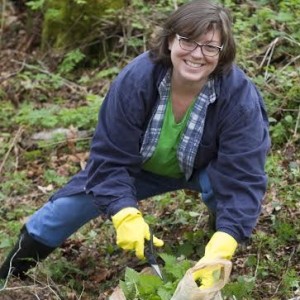Why, oh why, would I want to eat a wild plant that stings? My skin is so sensitive that I get rashes after a night on hotel sheets. Why would I voluntarily wander in the woods, plucking leaves that are famous for causing painful welts? Because, I’ve always wanted to test my culinary mettle with nettle. Last year I was particularly motivated because I wanted to include a nettle pesto recipe in Mastering Sauces.
Our friends, the magnificent Runnings, have several acres of wilderness and woods just half an hour away. Last year, my foraging adventure evolved into a feast and a pretty great party, so I invited myself over for a repeat performance. This year, instead of stressing about testing and logging recipes and the threat of serious allergic reaction, I was able to just have fun.
Nettles are treated as “no big deal” by locavore cooks and herbalists. The weeds have all sorts of advocates touting their nutritional value and medicinal uses. But if you’re anything like me, what you’ve always really wondered is -how do I get such an irritating plant out of the ground and into my mouth? And when I do, what will it taste like?
Let’s start with flavor. The taste is….green. Nettles simply aren’t the flavor dynamo I anticipated. They don’t have the bright, fresh, chlorophyll freshness of parsley, the perfume of basil, shiso, or sorrel nor the earthiness of spinach or chard. This year’s crop was milder than last year’s because we picked particularly young plants. Many weren’t even a foot tall. Last year, the nettles had a bit more of a minty, kale essence. The neutral taste carries other flavors very well. Dishes made with nettles tend to taste of the ingredients they are mixed with, but even the most refined and elegant preparation will retain a certain hint of untamed wilderness.
What nettles lack in flavor, they make up for in body. They are substantial without being especially coarse. When the leaves are stripped off the tough stems and blanched, they puree up nicely into a smooth, thick paste that makes excellent pestos and soups. The color is brilliant – a green that would make the Great and Powerful Oz weak at the knees. This year I realized that it’s that green that is the true magic of nettles. After a long, grey winter, those first sprouting leaves must have seemed like a medical miracle. Stinging hands and arms would seem trifling when faced with the prospect of another dinner of pemmican or pounded camas cakes.
I have so far remained “unstung” by donning rubber boots, long sleeves made of a thick material and rubber kitchen gloves. Use the long, goofy-looking ones made for washing dishes because they go further up your arms. My fellow pickers who wore short leather or latex food handler’s gloves got a few prickles. I picked only the tenderest tips, plucking the top two or three sprigs from plants there were barely a foot tall. The leaves were Kermity green and baby spinach sized. Next year I’ll add a few more mature leaves to boost the flavor. Like spinach, the leaves will cook down to nothing, so pick plenty. Many recipes call for 8 oz of whole leaves. I’d estimate that’s probably about 6 cups of loosely packed leaves from 10-12 cups of sprigs and it will make roughly 1 cup of puree.
Last year I just blanched the whole sprigs. The stems were pretty tender, but they made the paste a tad coarse. This year we meticulously removed each leaf and the resulting puree was more uniform and pulpy. Batches of nettles were cooked for about 30 seconds in boiling water, then “shocked” in ice water, drained, squeezed dry, and blended smooth. I stirred almost 2 cups of fresh nettle puree into a kettle of risotto dotted with asparagus, zucchini, and green peas. I stirred in a bit of butter, scattered the top with chives, and whisked it to the table. Gwen had sautéed some big leaf maple blossoms in garlic butter. Jeff had scrubbed some fiddle head ferns of their fuzz and dropped them into warm pickling brine. (They were terribly bitter this year. Next year I will blanch them first. ) A few additional dishes rounded out the menu.
I weighed the merits of freezing some of the blanched leaves. There is a certain appeal to randomly add nettles to a menu, but in the end I decided that the true appeal is the fleeting, seasonality and the good company involved in harvesting, preparing and sharing them.
Here is the nettle pesto I decided to put in the book.
Nettle and Avocado Pesto
From Mastering Sauces: The Home Cook’s Guide to New Techniques for Fresh Flavors
(W.W. Norton & Company, October 2015)
2 tablespoons minced shallot
2 cloves garlic
1 cup blanched fresh nettles, squeezed dry ( about 5 cups of loosely packed small leaves)
2 tablespoons minced chives
1 avocado, peeled and diced
1 teaspoon finely grated lemon zest
2 tablespoons freshly squeezed lemon juice
2 tablespoons avocado oil or light olive oil
Plenty of kosher salt and freshly ground black pepper to taste
In a food processor, chop the shallot and garlic. Add the nettles and chives and pulse until evenly blended. Add the avocado, lemon zest, and juice and blend to a paste while gradually adding 2 tablespoons of avocado oil or light olive oil. Season with plenty of salt and pepper.
Place a piece of plastic wrap or drizzle some additional oil on the surface of the pesto if not serving immediately to prevent oxidation. Serve with salmon, tossed with pasta, stirred into sautéed mushrooms, or as a dip with flat breads. The avocado will gradually darken the pesto.

